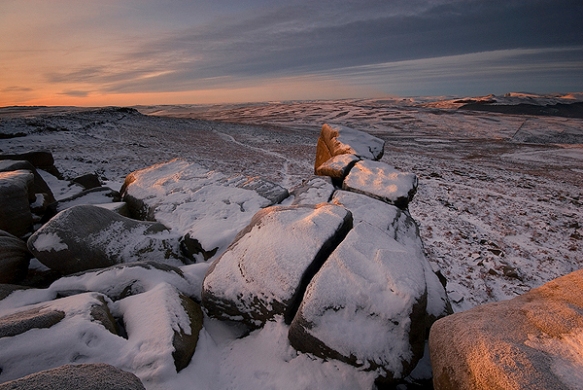The village of Loxley sits on the very edge of the Peak District National Park, to the west of Sheffield and now almost swallowed by urban sprawl.
Loxley Common lies between the villages of Wadsley, Worrall and Loxley, near Hillsborough. Today a popular spot for dog walkers, there are few clues now left to it’s somewhat dark and grisley past.
Roman artifacts have been found on the common and it is said that Mary Queen of Scots used to ride here, during the period that she was imprisoned at Sheffield Castle. The common was used to graze animals and collect wood for centuries and from the mid 19th century, ganister was mined here, for use in lining the furnaces of the local iron and steel works (1). Interestingly, recent discoveries have been made that could push use of the common back into prehistory.
The common is also home to the sword in the stone, a rock that bears the lightly incised carving of what looks like a broadsword. Little is known of the origin or date of this, but it will be interesting to hear of any future advances on this or the possible prehistoric remains.
Robin Hood’s supposed birthplace on a hillock at Little Haggas Croft (Loxley Firth), lies close to Loxley Common. It is near here where outlaws were said to wait for travellers between York and Peveril Castle (owned by the Sheriff of Nottingham), on their way to the hunting grounds of the Royal Forest of the Peak.
First mentioned in the Sloan Manuscript, dating from around the end of the 16th century, it is said that he was born around 1160. A survey by John Harrison in 1637 describes the Haggas Croft site as, “‘the foundacion (sic) of an house or cottage where Robin Hood was born’ (2). The ‘Gest of Robyn Hode’ (originally possibly dating from around the early 1400’s) certainly places Robin Hood in Yorkshire.
As well as the Robin Hood legend, the common is also the scene of other stories, including murder and gibbetting.
In c.1740, Thomas Halliday built the supposedly fire resistant Cave House on Loxley Common, over the entrance to a cave. The house was occupied by the local game keeper.
It was the evening of 30th December 1812 when Mary Revill was murdered in Cave House, stood lonely on Loxley Common. Her husband Lomas Revill, a game keeper, hadn’t come home that night. He had been seen in the local inn and was found the next morning in the gamekeeper’s cabin. deep in the woods. The night has seen a storm cover the common in deep snow and footprints leading from the cottage seemed to enter a cave on the brown of the ridge and disappear.
As time passed, Lomas Revill is said to have become a strange man and prematurely aged. As another New Year’s Eve approached, someone at the local inn remarked that the gamekeeper hadn’t been seen for a few days. A party of men went up to the cottage on the common and there in an outbuilding, found his body hanging from a rafter. The spectre of a white lady is said the haunt the area still.
Frank Fearn is a name that will be for ever associated with Loxley Common, for it was here where his gibbetted body hung in chains.
Frank Fearn was hung in 1782 (probably in York) for the murder of local watchmaker Nathan Andrews. He lured Andrews with a story of a pocket watch club (where customers would save weekly towards the cost of a pocket watch) at the Old Horns Inn at High Bradfield. En route to the Old Horns Inn, Fearn clubbed and stabbed Andrews to death on Kirk Edge Road and hid his body in a nearby copse.
Following his execution, his body was returned to Sheffield and gibbetted on Loxley Common, close to the scene of his crime. There it hung until Christmas Day 1797, when Frank’s bones finally fell from their chains. The land on which the gibbet stood, was purchased by Thomas Halliday, owner of the Robin Hood Inn as a tourist attraction. The land was later bought by John Payne, who’s descendants donated the land (Loxley and Wadsley Common) to the people of Sheffield in 1913.
In 1792 the body of Highway Man Spence Broughton was gibbetted at Attercliffe in Sheffield. His accomplice, John Oxley escaped from prison and hid out on Loxley Common. When spotted on the common, he committed suicide rather than face the same fate as Fearn and Broughton.
(1) Wadsley & Loxley Commoners: http://www.wadsley-loxley.org/history.html
(2) Quoted in Addy, A Glossary of Words Used in the Neighbourhood of Sheffield, p. lxxiii.
















